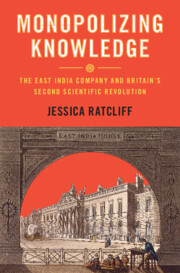Book contents
- Monopolizing Knowledge
- Science in History
- Monopolizing Knowledge
- Copyright page
- Dedication
- Contents
- Figures
- Acknowledgments
- Introduction
- Part I The Making of Company Science, 1600–1813
- Part II From Company Science to Public Science, 1813–1858
- 4 Patterns of Accumulation
- 5 Systematic Possession
- 6 Becoming National
- 7 The Commercializing Mission
- Conclusion
- Bibliography
- Index
Conclusion
from Part II - From Company Science to Public Science, 1813–1858
Published online by Cambridge University Press: 02 January 2025
- Monopolizing Knowledge
- Science in History
- Monopolizing Knowledge
- Copyright page
- Dedication
- Contents
- Figures
- Acknowledgments
- Introduction
- Part I The Making of Company Science, 1600–1813
- Part II From Company Science to Public Science, 1813–1858
- 4 Patterns of Accumulation
- 5 Systematic Possession
- 6 Becoming National
- 7 The Commercializing Mission
- Conclusion
- Bibliography
- Index
Summary
decades of Company rule, focusing on how a key issue of previous chapters – how contemporaries grappled with the question of just how Company science should serve national interests – was resolved, in part, by the rise of the “economic museum” movement and by new claims regarding the economic utility of the natural and human sciences. The first section considers new institutional developments in the connections between the India House library-museum and collections-based science institutions in the colonies. Increasingly, the India House library and museum would be represented as at the top of a hierarchy of respect to Company science establishments, reaching from London to the presidency governments and out into the rural divisions and settlements. The chapter then turns to the growing economic focus within the India House library-museum. The Company itself was no longer directly participating in trade, but it was responsible for the agricultural, industrial and other trade-related policies for British India, and the museum became closely tied to this. Some of the new responsibilities of the Reporter on the Products of India position were meant to aid the administrators in such areas of state. But the turn to a science of trade and industry was also, in part, the result of the directors more fully embracing the mission of making the library and museum useful for the (British) public by addressing industrialists, manufacturers and consumers in particular. Altogether, with a new, more clearly defined role as a mediator of industrial, educational and scientific relations between the home country and the colonies, these developments combined to bring new energy and purpose to the library and museum at India House. In almost exactly the same moment, however, the decisive undoing of the Company was brewing, brought on not by the free-trade liberals in Britain but by the resolute defiance of native soldiers in British India.
- Type
- Chapter
- Information
- Monopolizing KnowledgeThe East India Company and Britain's Second Scientific Revolution, pp. 257 - 261Publisher: Cambridge University PressPrint publication year: 2025

